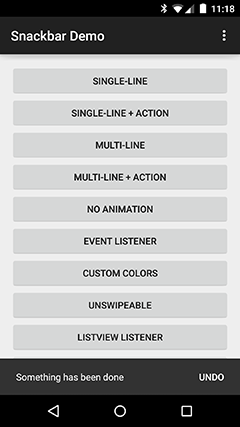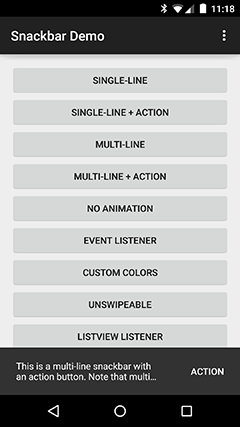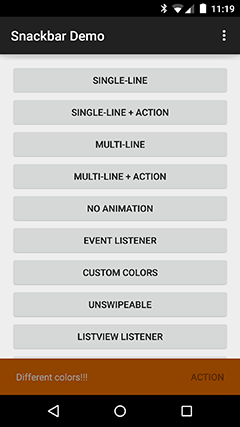Library that implements Snackbars from Google's Material Design documentation. Works on API levels >= 8

You can import the library from source as a module or grab via Gradle:
compile 'com.nispok:snackbar:2.7.5'Using the Snackbar class is easy, this is how you would display it on an Activity:
Snackbar.with(getApplicationContext()) // context
.text("Single-line snackbar") // text to display
.show(this); // activity where it is displayedHowever, I recommend you use the SnackbarManager to handle the Snackbars queue:
// Dismisses the Snackbar being shown, if any, and displays the new one
SnackbarManager.show(
Snackbar.with(myActivity)
.text("Single-line snackbar"));If you are using getApplicationContext() as the Context to create the Snackbar then you must
specify the target Activity when calling the SnackbarManager:
// Dismisses the Snackbar being shown, if any, and displays the new one
SnackbarManager.show(
Snackbar.with(getApplicationContext())
.text("Single-line snackbar"), myActivity);If you want an action button to be displayed, just assign a label and an ActionClickListener:
SnackbarManager.show(
Snackbar.with(getApplicationContext()) // context
.text("Item deleted") // text to display
.actionLabel("Undo") // action button label
.actionListener(new ActionClickListener() {
@Override
public void onActionClicked(Snackbar snackbar) {
Log.d(TAG, "Undoing something");
}
}) // action button's ActionClickListener
, this); // activity where it is displayedIf you need to know when the Snackbar is shown or dismissed, assign a EventListener to it.
This is useful if you need to move other objects while the Snackbar is displayed. For instance,
you can move a Floating Action Button up while the Snackbar is on screen:
SnackbarManager.show(
Snackbar.with(getApplicationContext()) // context
.text("This will do something when dismissed") // text to display
.eventListener(new EventListener() {
@Override
public void onShow(Snackbar snackbar) {
myFloatingActionButton.moveUp(snackbar.getHeight());
}
@Override
public void onShown(Snackbar snackbar) {
Log.i(TAG, String.format("Snackbar shown. Width: %d Height: %d Offset: %d",
snackbar.getWidth(), snackbar.getHeight(),
snackbar.getOffset()));
}
@Override
public void onDismiss(Snackbar snackbar) {
myFloatingActionButton.moveDown(snackbar.getHeight());
}
@Override
public void onDismissed(Snackbar snackbar) {
Log.i(TAG, String.format("Snackbar dismissed. Width: %d Height: %d Offset: %d",
snackbar.getWidth(), snackbar.getHeight(),
snackbar.getOffset()));
}
}) // Snackbar's EventListener
, this); // activity where it is displayedThere are two Snackbar types: single-line (default) and multi-line (2 lines max. Note this only applies for phones; tablets are always single-line). You can also set
the duration of the Snackbar similar to a
Toast.
The lengths of a Snackbar duration are:
LENGTH_SHORT: 2sLENGTH_LONG: 3.5s (default)LENGTH_INDEFINTE: Indefinite; ideal for persistent errors
You could also set a custom duration.
Animation disabling is also possible.
SnackbarManager.show(
Snackbar.with(getApplicationContext()) // context
.type(Snackbar.SnackbarType.MULTI_LINE) // Set is as a multi-line snackbar
.text("This is a multi-line snackbar. Keep in mind that snackbars are " +
"meant for VERY short messages") // text to be displayed
.duration(Snackbar.SnackbarDuration.LENGTH_SHORT) // make it shorter
.animation(false) // don't animate it
, this); // where it is displayedYou can also change the Snackbar's colors and fonts.
SnackbarManager.show(
Snackbar.with(getApplicationContext()) // context
.text("Different colors this time") // text to be displayed
.textColor(Color.GREEN) // change the text color
.textTypeface(myTypeface) // change the text font
.color(Color.BLUE) // change the background color
.actionLabel("Action") // action button label
.actionColor(Color.RED) // action button label color
.actionLabelTypeface(myTypeface) // change the action button font
.actionListener(new ActionClickListener() {
@Override
public void onActionClicked(Snackbar snackbar) {
Log.d(TAG, "Doing something");
}
}) // action button's ActionClickListener
, this); // activity where it is displayedFinally, you can attach the Snackbar to a AbsListView (ListView, GridView) or a RecyclerView.
SnackbarManager.show(
Snackbar.with(getApplicationContext()) // context
.type(Snackbar.SnackbarType.MULTI_LINE) // Set is as a multi-line snackbar
.text(R.string.message) // text to be displayed
.duration(Snackbar.SnackbarDuration.LENGTH_LONG)
.animation(false) // don't animate it
.attachToAbsListView(listView) // Attach to ListView - attachToRecyclerView() is for RecyclerViews
, this); // where it is displayedIt uses Roman Nurik's SwipeToDismiss sample code to implement the swipe-to-dismiss functionality. This is enabled by default. You can disable this if you don't want this functionality:
NOTE: This has no effect on apps running on APIs < 11; swiping will always be disabled in those cases
SnackbarManager.show(
Snackbar.with(SnackbarSampleActivity.this) // context
.text("Can't swipe this") // text to be displayed
.swipeToDismiss(false) // disable swipe-to-dismiss functionality
, this); // activity where it is displayedThere's a sample app included in the project. SnackbarSampleActivity is where you want to start.
If you would like to add features or report any bugs, open a PR or refer to the issues section.
Thanks to all contributors!
Go to the releases section for a brief description of each release.





